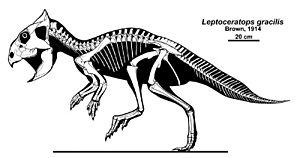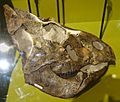Leptoceratops facts for kids
Quick facts for kids Leptoceratops |
|
|---|---|
 |
|
| Fossils at the Canadian Museum of Nature, Ottawa | |
| Scientific classification | |
| Genus: |
Leptoceratops
|
| Species: |
gracilis
|
Leptoceratops (say "LEP-toh-SER-uh-tops") means "slender horned face." This dinosaur was a stocky, strong animal. It had a big skull and a small horn on its beak-like snout. Leptoceratops lived during the Late Cretaceous period. This was about 68 to 65 million years ago. Its fossils have been found in Alberta, Canada, and Wyoming, USA. These places are both in North America. Scientists have found five skulls and other bones from this dinosaur.
Contents
Meet Leptoceratops, the "Slender Horned Face"
Leptoceratops was a type of ceratopsian dinosaur. This group of dinosaurs is known for having horns and frills. However, Leptoceratops was a bit different from its famous relatives like Triceratops. It was smaller and had a simpler look.
What Did Leptoceratops Look Like?
Leptoceratops was a stocky dinosaur. This means it had a strong, compact body. Its most noticeable feature was its large head. On its snout, it had a small horn. This horn was not as big or fancy as those on other horned dinosaurs. It also had a beak-like mouth, which was good for eating plants.
Where and When Did It Live?
Leptoceratops lived during the very end of the Upper Cretaceous period. This was a time when many dinosaurs were still around. It lived about 68 to 65 million years ago. Its fossils have been found in two main places. These are Alberta in Canada and Wyoming in the United States. Both of these areas are in North America.
How Do We Know About Leptoceratops?
Scientists learn about dinosaurs from their fossils. For Leptoceratops, they have found five skulls. They have also found other parts of its skeleton. These fossils help scientists understand what the dinosaur looked like. They also show what it ate and how it might have lived. The first Leptoceratops was described by Barnum Brown in 1914.
Images for kids
See also
 In Spanish: Leptoceratops gracilis para niños
In Spanish: Leptoceratops gracilis para niños




